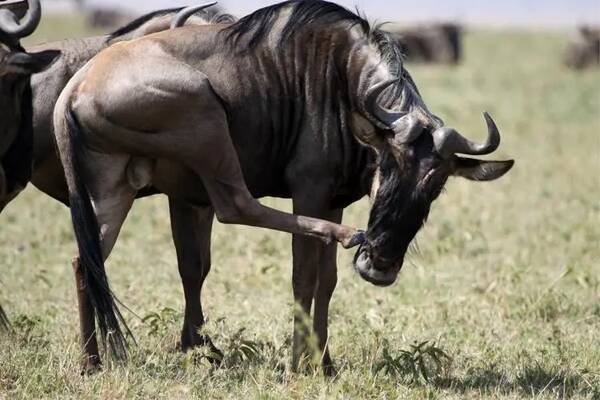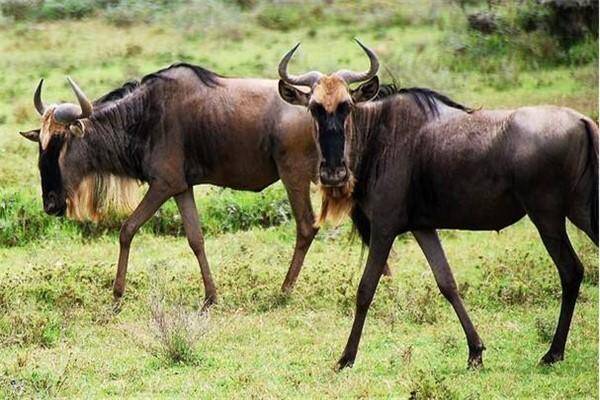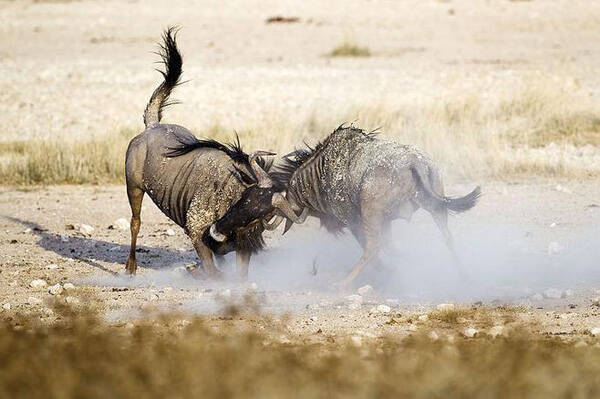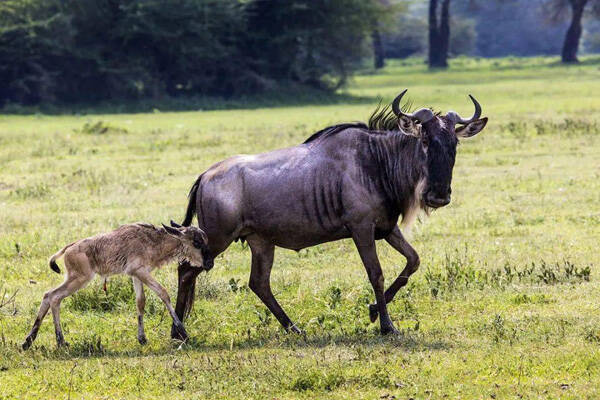Connochaetes taurinus
IUCN
LCBasic Information
Scientific classification
- name:Connochaetes taurinus
- Scientific Name:Connochaetes taurinus,Common Wildebeest,Common wildebeest, blue wildebeest, spotted wildebeest, white-bearded wildebeest
- Outline:Ungulata
- Family:Artiodactyla Bovidae Connochaetes
Vital signs
- length:1.8-2m
- Weight:118-270kg
- lifetime:About 20 years
Feature
It has a large head and broad shoulders like a buffalo, a slender back like a horse, and a black mane on its neck.
Distribution and Habitat
Origin: Angola, Botswana, Eswatini, Mozambique, Namibia, South Africa, United Republic of Tanzania, Zambia and Zimbabwe.
Extinct: Malawi.
Wildebeests are very adaptable to their environment, living on short-grass plains. They are found in a variety of habitats, from dense scrub to open woodland floodplains, scrub and woodland bordering albizzia savanna in dry areas. Wildebeests in the Serengeti thrive on short grasses on alkaline and volcanic soils during the rainy season, and migrate to other grasslands in areas with more frequent rainfall and water during the rainy season. However, they seem to prefer savannahs with albizzia trees and plains with fast-growing grasses and moderate soil moisture. Altitude 600-1,000 meters. Rarely found above 1,800-2,100 meters (e.g. Ngorongoro Crater).
Appearance
The wildebeest weighs 118-270 kg and is about 1.8 meters long. Adult males can reach more than 2 meters. It is a large herbivore. It looks like a cow, but its body is strong and between goats and antelopes, so it is called wildebeest. It has a thick head, a high and curved snout, a thick body and limbs, broad shoulders, a little hump on top, shoulders higher than hips, and a body that tilts backwards. Both males and females have horns, which are 30-40 cm long for females and 83 cm long for males. These horns are very similar to those of buffaloes, with a slightly wider base and no ridges. They bend from the top of the head to the sides, then bend upward and slightly inward, with the horn tips facing inward. The species has a beard-like, flowing black mane on the neck and under the jaw, which looks like dewdrops. The mane extends from the horns to the nape of the neck and all the way to the shoulders. The fur on the rest of the body is short and smooth, with dark vertical stripes on eit
Details
Common Wildebeest (Connochaetes taurinus) has five subspecies.

Common Wildebeest can have two or three territorial ranges, each corresponding to a specific season. These generally include dry and wet season territories, as well as a third transitional territory that not all wildebeest use. Transitional territories are usually geographically close to the dry season range, less than 20 km away. The distance between dry and wet season territories can be up to 120 km. Of the three territories, wet season territories are the smallest, and due to the higher population density, mating can be more efficient. The average territory size is 1.5 square kilometers. Adult males belong to their own territories, which may occupy their territories for weeks or all year round. Territory boundaries are marked by dung piles, preorbital gland secretions, and claw marks on the ground.
Dappled wildebeest like to group together, forming small groups in the wet season and large groups in the dry season. Groups of females are generally small, averaging about 8 females and juvenile males and calves. There are usually 2-25 wildebeest in the same area, divided into several small groups. When there is sufficient grass, 3 hectares of pasture are enough for a group of wildebeest. They are active in the early morning and evening, resting during the hot days. Older male wildebeests are mostly solitary. Each group of wildebeests is led by an adult male wildebeest. When the group moves, the strong individual leads and holds the line, and the other members follow one by one in the middle and walk along the trail. If they encounter enemies, the leading spotted wildebeest will lead the group to rush forward, unstoppable, until they are out of danger. With their strong bodies and strength, wildebeests can always drive away tufted deer, musk deer, serow and other ungulates that come to compete for food. This species is bloated in size, hunched over and staggering when walking, but can jump over 2.4-meter-high branches when necessary. The wildebeest team is very disciplined when marching, with strong male wildebeests walking in front and behind the team respectively, and female wildebeests and young wildebeests in the middle of the team. Wildebeest groups will not actively attack people, so they are less dangerous. But the temperament of a single wildebeest is different from that of wildebeests living in a group. Some wildebeests have been separated from their herds and have to "wander" alone. These wildebeests are irritable and can easily hurt people.
The herds formed by spotted wildebeests appear as loose but interconnected herds when they move. When migrating inland, they are determined by the availability of water and food. The most common living area of a group of wildebeests may be only a few hectares. However, as water and food sources shrink, they will move 50 kilometers to find better pastures. The herd is usually composed of about 8 females and their calves, while territorial male wildebeests wander between their herds. Temporary males will be driven away by territorial males. As the rainy season fades and food sources shrink, the herd structure decreases, and only young mothers and calves remain, and new food sources are also added.

Wildebeest communicate through sight, sound, and smell. A male's roar can be heard up to 2 kilometers away. Preorbital and foot gland secretions are important in olfactory communication, as are urine and feces. Foot glands guide herds to follow each other during migration. Wildebeests rub their preorbital glands on their backs and faces for social interaction, and they also use their noses to sniff the necks of other wildebeests.
The Great Migration of Wildebeests is a majestic and tragic natural miracle that occurs in eastern Africa. Millions of wildebeests embark on a long journey around June every year. Year after year, they play a hymn to life while seeking a way to survive in this way. The African grasslands are crossed by the equator and are close to the ocean. They are located in the alternating control area of the trade wind belt and the equatorial low pressure belt. During the period controlled by the equatorial low pressure belt, the precipitation is dense, providing a good environment for plant growth. When controlled by the trade wind belt, the temperature rises and the precipitation is very little. Under such harsh conditions, it is difficult for plants to grow and survive. In order to survive and reproduce, the Great Migration of Wildebeests makes it difficult for herbaceous plants to continue to grow under harsh climatic conditions, and some even die. Under these conditions, the grass on the East African savannah was gradually depleted and soon became insufficient to support the normal survival and reproduction of wildebeests. In order to obtain more food, wildebeests began to embark on a magnificent migration.
Wildebeests are herbivores that feed mainly on short grasses and alkaline soils found in savannas and plains. These grasses are fast-growing native grasses on savannas and plains: yellow-backed grass (Themeda triandra), large-flowered grass (Digitaria macroblephara) and pearl millet (Pennisetum mezianum). During the dry season, eating time increases by about 100%. Although the choice of diet remains the same in the dry and rainy seasons, the animals are more selective during the rainy season. When the grass is sparse, they may eat some leaves of shrubs and trees.

Wildebeest and plains zebras often forage in the same pastures, as plains zebras generally eat the less nutritious grass canopy of plants, exposing the greener plants underneath that wildebeests prefer to eat. Wildebeests need to drink water twice a day and usually live in moist grasslands and areas with available water sources. But they can also survive in the arid Kalahari Desert, where they can get enough water from melons and water-storing roots and tubers.
The main natural enemies of wildebeests are lions, cheetahs, spotted hyenas and African wild dogs. Large groups of wildebeests have more prey victims than small groups, which is considered a side effect of the size of the herd, because large groups of wildebeests tend to be less vigilant. When a potential predator targets a group of wildebeests, the wildebeests will roar loudly, making a piercing alarm call. Female wildebeests often fight desperately against a single hyena or cheetah to protect their calves, and there are examples of success.
Wildebeests are polygamous, and the mating estrus lasts for three weeks. Optimal breeding conditions occur immediately after the rainy season, coinciding with favorable climatic conditions, and conception rates are high. At this time, wildebeests can feed on lush grass. Male wildebeests in estrus will roar loudly, which can increase the production of testosterone and stimulate sperm production, which also leads to more calls and fights between males. Summer is generally the estrus period for wildebeests. In order to compete for mates, males in the wildebeest herd will duel and determine the hierarchy through "violent means". The loser will "anger" and run away from the herd, becoming a lone wildebeest. When there are females in estrus nearby, males do not sleep or eat, and continue to mate with as many females as possible.

During the calving season, pregnant female wildebeests, female wildebeests that have just calved, one-year-old wildebeests separated from female wildebeests, and single males are divided into different groups. Wildebeest mating occurs during collective migration. Whenever the herd stops, males herd the females together, running around them with their heads held high, and fighting with other competing males. Such groups can only last a few days. When the large herd moves again, they disband. When approaching mature females, bachelors and territorial males coax females with humming, roaring and squeaky serenades. Males compete for access to mates through direct physical contact, including sparring. Once a particular male has obtained the opportunity to mate, the female will remain near her mate, and dozens of matings may occur as long as the herd remains stationary. Calving usually occurs during migration to more fertile land, which also reduces the risk of predation.
Dappled wildebeest breed once a year, with a gestation period lasting 8 months and a single calf produced per litter. The average weight of a newborn wildebeest calf is about 19 kg. The calf can stand about 6 hours after birth. The mother must keep her calves close to her to ensure that the growth process is successful. The mother recognizes her calves initially by scent alone. During their first few months with their mothers, calves follow their mothers closely. Mothers protect their children and keep a distance from predators and male groups. In the event of conflicts and attacks, mothers and their calves continue to follow each other, but can become separated when the herd moves. When the calves are about 8 months old, they form groups that are equal to the mother's group. Females reach sexual maturity at 16 months, and males at 24 months. In the wild, the average age of the dappled wildebeest is 20 years, but the oldest individuals in captivity lived to 24 years old.
The total population of dappled wildebeest was estimated at 1.55 million in 2009, mainly due to the rebound of the species in the Serengeti to about 1.3 million. The populations of the other subspecies are estimated at 130,000 for the nominate, 5,000-10,000 for the Cookson, 50,000-75,000 for the Zambezi and a sharp decline to about 6,000-8,000 in 2016 for the white-bearded.
The dappled wildebeest was once very abundant, but the spread of human settlement and livestock, deforestation and acquisition of watershed areas, irrigation of farmland reducing water sources for wildlife, poaching for meat, and loss of some seasonal grassland areas for migration have reduced the number and distribution of the dappled wildebeest (2013). Fences block migration between the wet and dry seasons, and the species is blocked from accessing watersheds and high rainfall refuges during severe droughts, leading to mass mortality events. A notorious example is the decline in wildebeest caused by animal fencing in Botswana, which impedes drought-induced migration, notably the 1980 deaths of thousands of wildebeest at Lake Xau in the northeastern Kalahari Desert.
Due to seasonal use of unprotected pastures by some migratory populations, female wildebeest species are more vulnerable to illegal hunting and habitat loss as they become sedentary. In these cases, effective protection and management of national parks that cover only a portion of the species' annual range may not be enough to prevent declines in major populations. Migrant populations within protected areas are replaced by smaller (but still significant) resident populations, such as in areas such as Etosha National Park and the Central Galagadi Game Reserve. Some populations of wildebeest are naturally relatively sedentary, and their seasonal migrations are often contained within protected areas (e.g. on the Kafue, Luangwa, Hwange and Selous). The overall status of the species is unlikely to change if good representation in protected areas and private lands is maintained over the long term, but if conservation trends continue, wildebeest in fenced parks, reserves and farms will increasingly become sedentary (1999).








